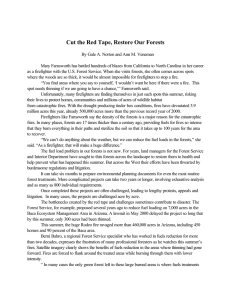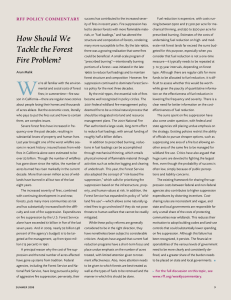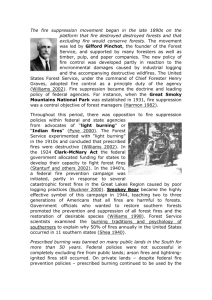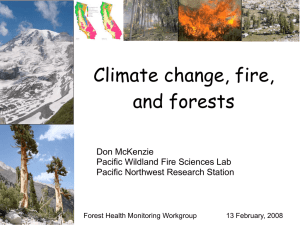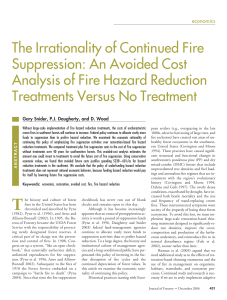prospecting. However, the largest and BY THERESA B. JAIN
advertisement
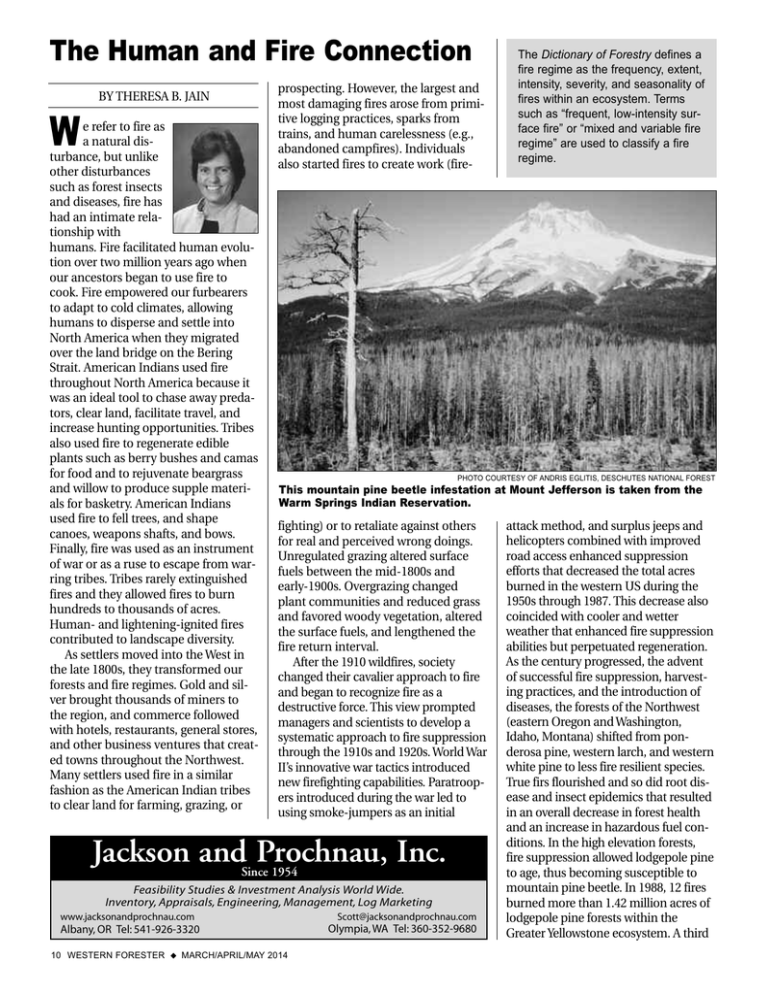
The Human and Fire Connection W BY THERESA B. JAIN e refer to fire as a natural disturbance, but unlike other disturbances such as forest insects and diseases, fire has had an intimate relationship with humans. Fire facilitated human evolution over two million years ago when our ancestors began to use fire to cook. Fire empowered our furbearers to adapt to cold climates, allowing humans to disperse and settle into North America when they migrated over the land bridge on the Bering Strait. American Indians used fire throughout North America because it was an ideal tool to chase away predators, clear land, facilitate travel, and increase hunting opportunities. Tribes also used fire to regenerate edible plants such as berry bushes and camas for food and to rejuvenate beargrass and willow to produce supple materials for basketry. American Indians used fire to fell trees, and shape canoes, weapons shafts, and bows. Finally, fire was used as an instrument of war or as a ruse to escape from warring tribes. Tribes rarely extinguished fires and they allowed fires to burn hundreds to thousands of acres. Human- and lightening-ignited fires contributed to landscape diversity. As settlers moved into the West in the late 1800s, they transformed our forests and fire regimes. Gold and silver brought thousands of miners to the region, and commerce followed with hotels, restaurants, general stores, and other business ventures that created towns throughout the Northwest. Many settlers used fire in a similar fashion as the American Indian tribes to clear land for farming, grazing, or prospecting. However, the largest and most damaging fires arose from primitive logging practices, sparks from trains, and human carelessness (e.g., abandoned campfires). Individuals also started fires to create work (fire- The Dictionary of Forestry defines a fire regime as the frequency, extent, intensity, severity, and seasonality of fires within an ecosystem. Terms such as “frequent, low-intensity surface fire” or “mixed and variable fire regime” are used to classify a fire regime. PHOTO COURTESY OF ANDRIS EGLITIS, DESCHUTES NATIONAL FOREST This mountain pine beetle infestation at Mount Jefferson is taken from the Warm Springs Indian Reservation. fighting) or to retaliate against others for real and perceived wrong doings. Unregulated grazing altered surface fuels between the mid-1800s and early-1900s. Overgrazing changed plant communities and reduced grass and favored woody vegetation, altered the surface fuels, and lengthened the fire return interval. After the 1910 wildfires, society changed their cavalier approach to fire and began to recognize fire as a destructive force. This view prompted managers and scientists to develop a systematic approach to fire suppression through the 1910s and 1920s. World War II’s innovative war tactics introduced new firefighting capabilities. Paratroopers introduced during the war led to using smoke-jumpers as an initial Jackson and Prochnau, Inc. Since 1954 Feasibility Studies & Investment Analysis World Wide. Inventory, Appraisals, Engineering, Management, Log Marketing www.jacksonandprochnau.com Albany, OR Tel: 541-926-3320 10 WESTERN FORESTER ◆ MARCH/APRIL/MAY 2014 Scott@jacksonandprochnau.com Olympia, WA Tel: 360-352-9680 attack method, and surplus jeeps and helicopters combined with improved road access enhanced suppression efforts that decreased the total acres burned in the western US during the 1950s through 1987. This decrease also coincided with cooler and wetter weather that enhanced fire suppression abilities but perpetuated regeneration. As the century progressed, the advent of successful fire suppression, harvesting practices, and the introduction of diseases, the forests of the Northwest (eastern Oregon and Washington, Idaho, Montana) shifted from ponderosa pine, western larch, and western white pine to less fire resilient species. True firs flourished and so did root disease and insect epidemics that resulted in an overall decrease in forest health and an increase in hazardous fuel conditions. In the high elevation forests, fire suppression allowed lodgepole pine to age, thus becoming susceptible to mountain pine beetle. In 1988, 12 fires burned more than 1.42 million acres of lodgepole pine forests within the Greater Yellowstone ecosystem. A third (794,000 acres) of Yellowstone National Park burned and cost the United States government $120 million to fight. Yellowstone was the first large fire the United States had experienced in decades, but it definitely was not going to be the last. The 2000 fire season burned nearly 7 million acres and cost the United States government $1.6 billion. These fires led to a shift in fire policy. First, Congress directed the five federal agencies (Forest Service, Bureau of Land Management, Park Service, Bureau of Indian Affairs, and Fish and Wildlife Service) to standardize all aspects of wildfire response. Second, Congress established the National Fire Plan to diminish the growing threats of large, costly, and life-threatening wildfires. This plan provided funding to ensure sufficient firefighting resources, to rehabilitate and restore fire-damaged ecosystems, to reduce fuels in forests and rangelands (particularly near communities), and to work with local residents to reduce fire risk and improve fire protection. Even with this plan, large fires have continued to burn Northwest landscapes, including the 2002 Biscuit Fire (500,000 acres), 2007 Cascade Complex (302,376 acres), and 2006 Tripod Complex (113,011 acres) that burned close to a combined one million acres. In 2009, the Federal Land Assistance, Management and Enhancement (FLAME) Act directed the development of the National Cohesive Wildland Fire Management Strategy (cohesive strategy). The cohesive strategy uses a collaborative process at all levels of government and non-governmental organizations and the public to seek national all-lands solutions to wildland fire management issues. The cohesive strategy is to systematically develop a dynamic approach to: 1) restore and maintain resilient landscapes; 2) create fireadapted communities; and 3) improve suppression response to wildfires (www.forestsandrangelands.gov/strategy/overview.shtml). Fires do have significant positive effects on forest ecosystems and create conditions that sustain many forest characteristics we value. They produce snags and down wood for bats, birds, and mammals to use for dens, perches, and hiding cover. They kill trees and create openings where grasses, forbs, and shrubs flourish, and that enhance forage for ungulates (deer, elk, and moose). Soils, if scorched by fire, can release nutrients allowing quick vegetation recovery. In dry and mixed-dry conifer forests, ponderosa pine and western larch flourished because fires removed competition. After fire, lodgepole pine forests regenerate and begin another growth cycle—a positive outcome from the Yellowstone fires. Fuel (live and dead vegetation), topography, and weather influence wildfire behavior and effects, and historically this combination produced a complex mosaic of vegetation compositions and structures that made these forests fire resilient. Large fires will continue to occur, particularly if hot, dry summers lengthen the fire season. Fuel treatment placement and effectiveness can mitigate fire’s destructive role; however, fuel treatments also have limitations. They will not fire proof a forest. Fuel includes all live and dead vegetation and given the right conditions (wind, drought, high temperatures), fires can burn through fuel treatments in undesirable ways. Fuel treatments continue to grow and develop over time, thus fuel maintenance is a necessary piece of fuels management. Even large and extensive landscapelevel fuel treatments may not reduce the size of area burned or how quickly a fire burns through a landscape. However, if applied in the right place, fuel treatments can provide suppression opportunities and alter post-fire outcomes. The challenge is to identify the best places (close to homes and in the landscape), treatment methods, and maintenance schedules so when a wildfire does occur, it performs as we expect and actually contributes to the future resilience of our forests. ◆ Theresa B. Jain is a research forester with the Rocky Mountain Research Station in Moscow, Idaho. She can be reached at 208-883-2331 or tjain@fs.fed.us. For Further Reading Pausas J.G. and Keeley, J.E. A burning story: the role of fire in the history of life. BioScience 59(7): 593-601. Pyne, S.J. 1982. Fire in America: a cultural history of wildland and rural fire. Princeton, NJ: Princeton University Press. 654 p Mann, C.C. 2011. 1493: uncovering the new world Columbus created. New York: Alfred A. Knopf. 535 p. Jain, Theresa B.; Battaglia, Mike A.; Han, Han-Sup; Graham, Russell T.; Keyes, Christopher R.; Fried, Jeremy S.; Sandquist, Jonathan E. 2012. A comprehensive guide to fuel management practices for dry mixed conifer forests in the northwestern United States. Gen. Tech. Rep. RMRS-GTR-292. Fort Collins, CO: U.S. Department of Agriculture, Forest Service, Rocky Mountain Research Station. 331 p. WESTERN FORESTER ◆ MARCH/APRIL/MAY 2014 11
